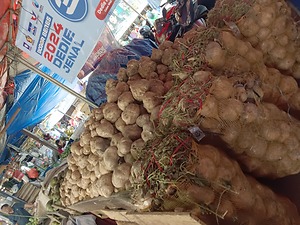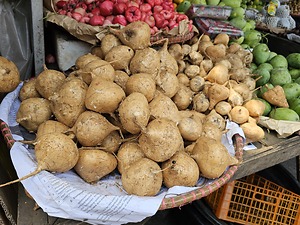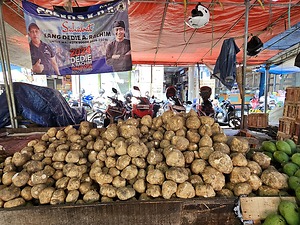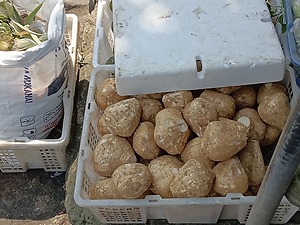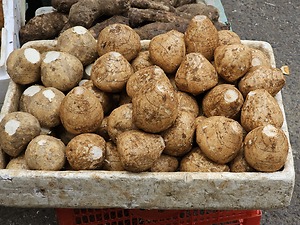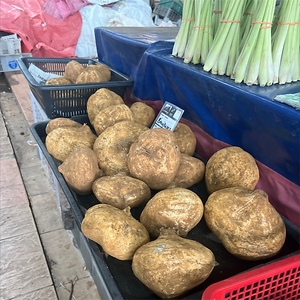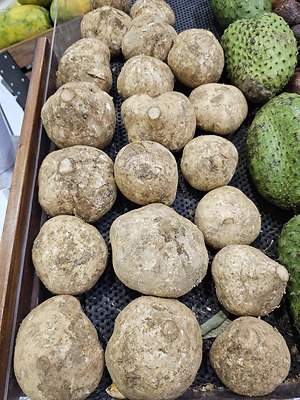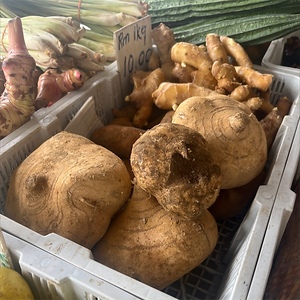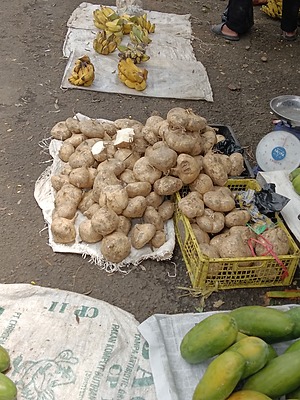

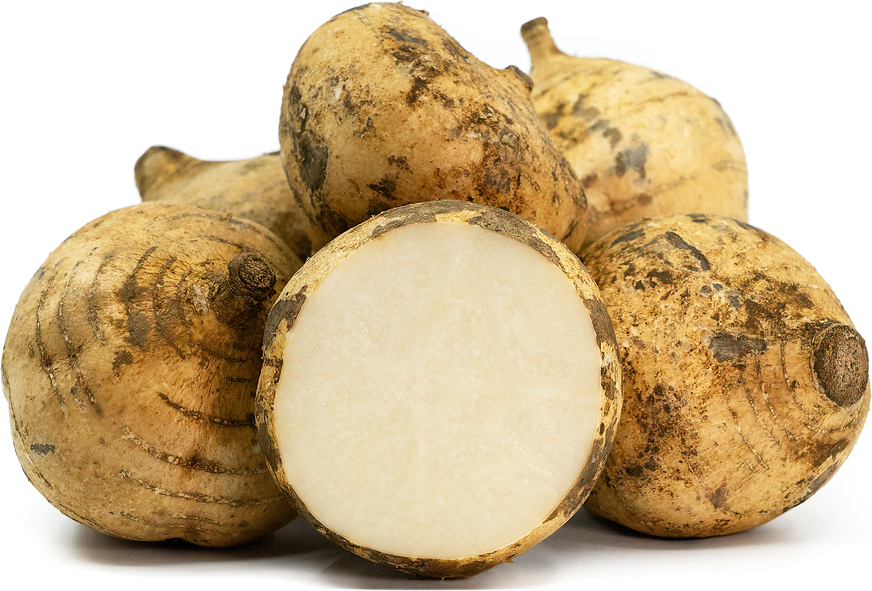
Sengkuang
Estimated Inventory, lb : 0
Description/Taste
Sengkuang is a medium to large root sold commercially in sizes averaging 10 to 15 centimeters in diameter and under two kilograms in weight. In home gardens, the roots can grow to over two meters in length and weigh up to twenty kilograms. The heaviest Sengkuang ever recorded weighed 23 kilograms and was found in 2010 in the Philippines. Sengkuang ranges in size, shape, and appearance, depending on the specific variety and growing conditions, and the roots can be found in spherical, oval, oblong, to conical shapes. The root's skin is thick, fibrous, hard, and tough, giving the surface a dry, flaky, and coarse texture. Despite its rugged nature, the skin is easy to slice from the flesh and should be discarded before culinary use. The skin also varies in color from tan, brown, to dark brown, and some roots will showcase all three colorings. Exterior imperfections may not be an indicator of the flesh's quality, as Sengkuang is frequently bruised, scarred, or scratched. Underneath the surface, the white to ivory flesh is solid, aqueous, and dense with a crisp, crunchy, and snappy consistency. The flesh is also abundant in translucent juice, giving it a watery, refreshing nature. Sengkuang can be peeled and eaten raw or cooked. The flesh is mild, neutral, sweet, subtly nutty, and slightly tangy.
Seasons/Availability
Sengkuang is available year-round in tropical climates, with a peak season in the winter through late spring.
Current Facts
Sengkuang, botanically classified as Pachyrhizus erosus, is the taproot of an herbaceous plant belonging to the Fabaceae or legume family. The crisp, fleshy roots grow underground beneath a climbing vine spreading 4 to 5 meters in length, and the roots are the only edible portion of the plant. The species Pachyrhizus erosus is native to the Americas and is internationally known as Jicama, but it was also introduced to Southeast Asia and East Asia in the 17th century. Sengkuang is the Malaysian name for the root, and the species is also known as Singkamas in the Philippines, Dou Shu and Sha Ge in Mandarin, Sah Kok in Cantonese, Bang Kuang in Hokkien, and Yam bean, Sweet turnip, Chinese turnip, and Mexican Water turnip outside of Asia. Sengkuang takes approximately 3 to 9 months to mature in frost-free climates, and the edible root is favored for its crisp, refreshing, and subtly sweet flavor. Since its introduction in the 17th century, Sengkuang has become established as a popular root vegetable throughout Southeast Asia and is used in fresh and cooked preparations.
Nutritional Value
Sengkuang is a source of potassium to balance fluid levels within the body, fiber to regulate the digestive tract, and vitamin C to strengthen the immune system. The roots also provide calcium to build strong bones and teeth, vitamin A to maintain healthy organ functioning, vitamin E to protect the cells against the damage caused by free radicals, magnesium to regulate blood pressure, and other nutrients, including zinc, phosphorus, manganese, vitamin K, and folate. It is important to note that the root's skin is inedible as it contains rotenone, a naturally occurring compound used as an insecticide.
Applications
Sengkuang has a mild, subtly sweet, and nutty taste suited for fresh and cooked preparations. The roots are primarily consumed raw and are favored for their refreshing, crisp, and watery consistency. The skin must be removed prior to consumption and should be discarded. Once trimmed, the flesh can be sliced into wedges and served with dips, cut into strips on charcuterie boards, or sprinkled with lime or lemon juice, chili powder, or salt as a tangy snack. Sengkuang can also be shredded into salads. In Indonesia, Sengkuang is combined with other fresh vegetables in a dish known as gado-gado and is drizzled in a savory peanut sauce. Try incorporating Sengkuang into sandwiches for an added crunch, or marinate the flesh in aromatics and spices for enhanced flavoring. In addition to fresh preparations, Sengkuang can be lightly cooked and still retains its crunchy consistency. The flesh can be added to soups, curries, and stews, cooked into fritters, served with fish, or stir-fried, wrapped in lettuce, and consumed as an appetizer. In Southeast Asia, Sengkuang is combined into popiah, a fresh spring roll, or fried into lumpia. Sengkuang is also chopped and mixed with rice vinegar, fermented shrimp paste, salt, and chile peppers into rujak, a condiment commonly served in Indonesia and Malaysia. In addition to fresh and cooked preparations, the roots can be dried and ground into flour for use in desserts, tortillas, pancakes, and bread. Sengkuang pairs well with citrus, aromatics such as ginger, garlic, and onions, flavorings including soy sauce, sesame oil, and oyster sauce, shiitake mushrooms, carrots, cucumbers, leafy greens, fruits such as pineapple, orange, and papaya. Whole, unpeeled Sengkuang will keep for a few days at room temperature and for 1 to 2 weeks when stored in the refrigerator. Once peeled, the flesh should be wrapped in plastic and consumed within a few days.
Ethnic/Cultural Info
During the Lunar New Year, Sengkuang brings prosperity when tossed into the air. In Malaysia and Singapore, Sengkuang is traditionally incorporated into a salad known as yusheng, and this fresh dish combines vegetables, spices, aromatics, sauces, and often fish. The origins of yusheng are unknown, but it is said the salad may have been created in the 1960s in Singapore, stemming from other Chinese New Year's customs. Yusheng translates from Mandarin to mean "raw fish," and the pronunciation of "yu" is also a homophone for another Chinese word meaning "abundance." This similarity in sounds is believed to be lucky, and during New Year celebrations, the salad is tossed in the air with chopsticks to welcome prosperity in the coming year. All the guests partaking in the meal will have a set of chopsticks to communally toss the salad, and while the ingredients are being lifted, the group yells "lo hei" and shouts auspicious phrases as blessings for the year to come. The higher the salad is tossed, the more luck and prosperity will be given in the new year. The interactive dining experience is also believed to symbolize harmony and unity between family and friends, and ingredients are hand-picked to represent wealth, health, beauty, happiness, and luck.
Geography/History
Sengkuang is native to Mexico and Central America and has been growing wild since ancient times. Evidence of the species can be traced back to ancient sites in Peru dating to 3,000 BCE, and the roots were mentioned in Chilam Balam, Mayan manuscripts written from ancient hieroglyphics in the 17th and 18th centuries. Sengkuang was extensively cultivated and utilized as a food source for centuries in the Americas, also grown by the Aztecs, and in the 17th century, Spanish explorers carried Sengkuang from Mexico to the Philippines. Sailors stowed Sengkuang on their ships as a source of hydration, nutrition, and as a refreshing snack. The roots would last for several weeks without the need for refrigeration and were able to be consumed raw as a fast meal. Once Sengkuang was introduced into the Philippines, it spread over time throughout Southeast Asia and into East Asia, where it was naturalized and grown as a commercial and home garden crop. Today Sengkuang is cultivated worldwide in tropical to sub-tropical climates. When available, Sengkuang is sold through fresh markets, select retailers, and distributors throughout Asia and Southeast Asia. It is also sold in other regions worldwide under various names.
Recipe Ideas
Recipes that include Sengkuang. One
| Jackie M |
|
Crispy Sengkuang Fritters |
| Jackie M |
|
Crispy Sengkuang (Yam Bean) Fritters |
| Nyonya Cooking |
|
Jiu Hu Char |
| SBS Australia |
|
Stir-Fried Cuttlefish with Vegetables |
| Health Works |
|
Stir-Fried Sengkuang |



